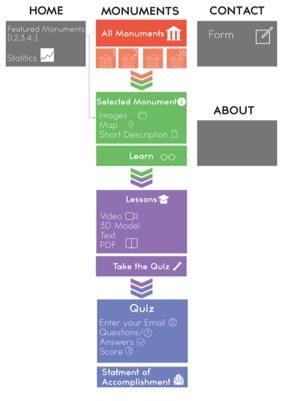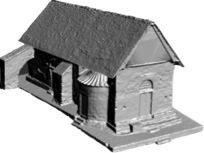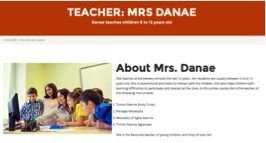REUSING CULTURAL HERITAGE DIGITAL DATA TO DEVELOP AN EDUCATIONAL WEB PORTAL FOR CYPRIOT UNESCO MONUMENTS
Digital Heritage Research Lab, Cyprus University of Technology[1]
At the beginning of the 21st century, technology had reached a point where the digitization of Cultural Heritage (CH) and massive storage of CH data was economically efficient and, on the other hand, due to human thread and massive environmental destruction there was a need for massive CH digitization. This fact has led to the formation of a high interest in turning the material into digital, for the information to be easily detected and retrieved and the knowledge to be widely and equally accessible. At the same time the Digital Agenda for Europe, promotes the creation, production and distribution of digital content and services for a creative, vibrant single market. [1] Reuse of Digital CH content is taking place now in Europe, characterized by the Europeana projects (Europeana Creative, E-Space, Europeana Food & Drink etc.), where experimental business models, innovative approaches and services are developed using Europe’s biggest -in digital items- library. [2] The concept of “use and reuse” of Digital CH Data has been established, while at the same time a demand developed for the further evolution of the technology in order to facilitate the exponential growth of the created content (big data) and their preservation.
This project is a research on reusing CH Data for educating people (grown-ups and kids) on Monuments that are listed at UNESCO Monuments World Heritage Catalogue, in Cyprus. The system uses innovative digital heritage resources, in order to help the user, in a friendly UX, to learn about the different phases of the monument, the history, the architectural value and the conservation stage. The resulting platform is accessible through smart devices and desktop computers, (in the frame of “Bring Your Own Device” a.k.a. BYOD). The main challenge was the use of Europeana Data (Pictures and the 3D objects) in a way that the information on the platform would be comprehensible by the users. Computer technologies allow various visualizations and digital re-constructions of archaeological monuments and sites. These models can be integrated in a demonstration to be developed as an educational user friendly platform by using the Europeana (and other creative commons) collections. The work started with a preliminary search on Europeana and other online management galleries and the identification of objects/monument for the demonstration. It then used the images and models that can be found on Europeana as thumbnails and that can be reached through Europeana on the holders’ websites. When the objects are of high quality and ready, then they can be offered for free use to education, architecture, historians, civil engineers, students, etc. The tool will be available by the end of the project as a Pilot test platform for primary, secondary, tertiary educational levels, and also to support vocational training (for archaeologists, preservation, protection of monuments and sites), and the tourist industry (for example guides). An evaluation plan has been set up in order to have the first results from our target users, their reactions to the content and how the platform could be implemented at an educational environment and teaching procedure.
The basic aim of the project is the development of a system of digital information, education and entertainment (edutainment) for adults, adolescents and teenagers concerning the most representative monuments and landmarks of Cyprus, reusing existing Cultural Heritage data from Europeana.
The proposed UNESCO monuments digital learning system will further aim to:
- Help users to learn the history of the UNESCO monument
- Educate users in architecture and cultural heritage
- Raise awareness on protecting and conserving our heritage
- Promote the UNESCO Monuments
- Inform on risks that threaten the Monuments
Taking into consideration all the aforementioned limitations, we adopted our project to the content we had available. Certain images and 3D models of UNESCO’s monuments in Cyprus were used in order to form the educational content of the platform. The presented educational tool responds to the multicultural features of present era but at the same time to the contemporary pedagogical and methodological directions.
Nowadays, the challenge of re-using digitized cultural heritage content from Open Repositories is addressed by scientists, practitioners, professionals and institutions of the related field. One of the areas that re-use can yield fruit is education. On the one hand, arts and cultural heritage education has been regarded as the key factors in development of the knowledge society and creative ability [3]. On the other hand, the ongoing development of Information and Communication Technologies (ICTs) is providing new opportunities of representation and interpretation of cultural heritage. Thus, learning about cultural heritage with the mediation of ICT tools and methods – in our case the e-learning platform enriched with multimedia content – can be effective in all educational levels by using appropriately the available ICT affordances.
“Reuse of Cultural Heritage digital data is important because it enhances creative entrepreneurship, promotes research, encouraging information accessibility & dissemination, and adds great value for education were everyone can learn, copy and share knowledge in and out of the classroom.”
Information technology and the “culture of the image” gradually and steadily gain a key role in school learning while at the same time there is a constant fervent effort in the modern educational systems to functionally and effectively integrate the ‘new media’ both as teaching tools and as a distinct separate school subject (in ventures of a reformation/review of the content of the existing curricula). Besides all this, the most important reason for using digital tools in education is because it constitutes an entertaining way for the acquisition of knowledge and it can compose a refreshing change to the daily school routine enhancing children’s enthusiasm [4]. Apart from underage learners, we also aim to engage adolescents, adults as well as vocational trainers in learning and becoming aware of these historic monuments. Learning about the culture, the living conditions, the human creations and attitudes in the course of time, understanding the historic-cultural events and the evolution of society, and finally discerning what has survived at the sociocultural surroundings, is the quintessence of arts and cultural heritage education. But in order to achieve the favourable learning outcome, there are four learning approaches that we employed for ensuring the values of ICTs in cultural heritage education: (a) Personalized, inquiry-based learning approaches (b) On-site and anywhere learning experiences (c) Interdisciplinary learning approaches and (d) Collaborative learning experiences [3].
“Every monument is a different online course. Virtual instructors (VI) are teaching different courses and ages. This way, teachers who wish to use the portal, are following specific VI, depending on the ages of their students.”
Each one of these approaches has its origins to the main changes brought by the massive and precise digitalisation of Cultural Heritage in the recent years. Every single cultural artefact becomes digital in a way that its primary ontological value is expanded. For instance, images of such artefacts are no longer bi-dimensional; their detailed and zooming abilities allow users to study and interact with them in any preferred dimensional level. What is more, zooming out of those images puts cultural artefacts into a wider context that reveals where they lie on or have been created. These are perspectives that can adopt innovative approaches to teaching and learning [3]. In the sections below, it is analysed how we manage to approximate the aforementioned approaches to the online educational platform.

The UX Design of the platform, follows other online MOOC portals’ design that users are familiar with.
First of all, it was very important that the design of the online educational platform would follow the “bring your own device” (BYOD). There has been an increasing interest in supporting BYOD in schools by growing support from students, parents, and teachers. In order to achieve a more personalized and possible on-site and anywhere learning experience, we developed a platform compatible to all smart devices (android, iPhone, iPad, windows tablets). A responsive web site was decided to be used, with the capability to run on desktop and portable devices. The design of the platform is based on an Educational Theme (WordPress) with CSS reconfiguration. The decision for an Educational Theme was taken in order to use an environment familiar to most of the visitors (both students and teachers). Since it is widely regarded that the most common used educational platforms at the internet are Coursera, Udacity, edX etc. [5], [6], we use similar User Interface design so that is familiar to the users. This way we cover the UX Design requirement. Having in mind that the challenge is to use the Europeana Data (mostly photogrammetric pictures and 3D objects) in a way that the information on the platform will be comprehensible by the users, data should be presented in an appropriate way so to cover all the users’ spectrum. Most of the data have little metadata information and they lack history and cultural value description (semantics). Even when we have this information, we need to adjust the data to make the information useful for educators and people that are not familiar with cultural heritage. The first step was to design a detailed Site Map, taking under consideration the UX Design guidelines.

Sitemap of the platform.
As one can see at the demonstrator site (http://wp.digitalheritagelab.eu ), every monument is a different “Course”. Every course has a number of lessons, just like in any online education portal. The information about the monument is divided to separate lessons, as follows:

Example of a monument.
- Lesson about the History of the Monument.
- Lesson about the Local History: Short reference on the local history through the literature study.
- Video: Short dramatized video, which presents on a descriptive and communicative dimension the key elements that anyone should know about the monument (in an understandable form, suitably subtitled for both adults and children).
- Glossary: important words that are used at the text.
- The 3D object (downloadable in a pdf file and in a simple online version).
- Comprehension questions.
- Activities: Puzzles, Hotspot images, Games.
- Quiz: A short quiz (usually 10-20 Questions) about the Monument. You need to score 70% in order to pass.
- References: Resources and links for further studying.

Lessons on the monument: every Monument is a different course, with a variety of tools to engage with the user.
In every lesson, there is a time estimation, to help educators and users to manage their own time and pace when studying about the monument. At the end, there is a “Review” section. Every visitor can write a review and choose 1 – 5 stars for the course. This way, courses with better score will be proposed at the Home Page. Finally, users can print a “statement of accomplishment” of the Course, if they pass the Quiz.
The web site, as an educational tool, uses different digital heritage data depending on the age of the users. For kids aged between 6 and 10 years old, the ortho-rectified pictures were used as a puzzle game. For older kids the same pictures can be used as “find the hot-spot” game, were useful information is hidden under different hot-spots of the image. In all ages, 3D models of the Monument are used to encourage interaction but – most important – to give the teacher the opportunity to download and 3D print the model. This way, the kids can touch, paint and interact with the Monument’s model, enriching the overall learning experience. Furthermore, students could be divided into groups (either e-course is a lesson inside the classroom or homework assignment) so to foster collaboration among them to produce shared ideas and form knowledge through communication and interaction. What is also achievable via the e-learning platform is the collaboration between students from different schools, either Cypriot or International. These collaborative learning experiences are available by the proper use of such ICT tools.

Puzzles were developed for younger ages (6-10 years old), reusing photogrammetric images of frescoes.
At the same time, the content of every lesson is different, depending on the ages of the users. For users aged over 16 years old, for life-learning users and for vocational training, the content is more advanced; the glossary is more complex and the demands (quiz, comprehensive questions) are higher. The courses (monuments) that are addressed for younger children, the content is simplified according to their age. In order to organize the courses and improve the user experience of the site, three virtual teachers were developed. Each teacher has different ages in her/his virtual classroom and different courses (monuments). This way, if an educator teaches i.e. elementary school, she/he would follow the elementary school virtual teacher, using fast and efficient the correct courses for the classroom.

For high school kids, the “hot-spot” game was preferred, were information is hidden in panoramic pictures of the church.
FUTURE
An evaluation of the platform is planned to be conducted with (a subset of) our target users participating at the procedure. The evaluation of the educational aspect of the platform will follow a methodology of joint techniques, in order to have a more integrated and overall view of the evaluation results. In this phase, that a prototype of the platform is completed and running successfully, we intend to run a formative evaluation. Students are the most important evaluators with the, most difficult and intensive to design, evaluation technique. The “special group session” (focus group) is a technique of qualitative data collection, in which a small number of participants (usually 4-9 people) discuss and comment on a specific topic, under the guidance of a trained mediator. Participants are distinguished by some common characteristics, such as their relationship with the matter under investigation, but also by the growing dynamic between them during the session [8]. The value of this technique is based on the interaction and the ‘chemistry’ that can be developed between the participants, which encourages them to express freely and with intimacy, unobstructed views, attitudes and ideas they have about the subject matter, agreements or disagreements with the opinions or attitudes of the other attendees [9]. All these are describing a full educational context when learning is taking place inside the classroom. Such forms of rich interactions and dialogs we are expecting to record from students.

Virtual instructors teach different ages and monuments.
RESULTS
Today is obvious that we have a lot of digital data (especially from crowdsourcing platforms like Europeana) with controversial information. If any student, educator or simple user needs to learn or study the history of a monument, usually she/he ends up (through google search) to huge number of information, text, picture (with no obvious connection or order) and without the semantics or the metadata that they need to study the Monument.
In order to achieve rigid results, we combined the Europeana and Open Source Data on the Internet, with an educational tool. The model construction is based on the cross-cultural approach, which responds to the multicultural features of present era but at the same time to the contemporary pedagogical and methodological directions.
The result is an online learning user-friendly experience, where visitors (educators, students and simple users) have the opportunity to read, watch, interact (3D model) and test their knowledge in cultural heritage. The information is adjusted to their needs and if they finish the Course successfully, they can use the references to deepen their knowledge.
The affordances described above: personalized content for different ages, roles (teachers – students), professionals, can be furthered integrated with interdisciplinary learning dimensions. Specific objects can be linked with external or internal data to related sources from various relevant disciplines. An existed network could be broadened with historical, socio-cultural, economical and other geographical links, which allow a stronger interpretation of the presented cultural artefact itself [7].
Moreover, one of the future features of the platform would be the ability to provide a 3D model of the monument constructed by photographs taken by actual users being on the site’s physical environment. For cultural e-courses this kind of personalized e-learning functionality, and therefore personalized interaction, is one of the most important requirements [7].


Last but not least, Europeana’s content enrichment with Image Based Modelling Data is considered to be vital in order to overcome the existing obstacles and limitations and to provide the user with superior robusting experiences.
Reference
[1] EU, “Ict Psp Work Programme 2012,” p. 78, 2012.
[2] D. R. Tobergte and S. Curtis, “Europeana Creative: Where Cultural Heritage and Creative Industries Meet to Re-Use Europe’s Digital Memories,” J. Chem. Inf. Model., vol. 53, no. 9, pp. 1689–1699, 2013.
[3] M. Ott and F. Pozzi, “ICT and Cultural Heritage Education: Which Added Value?,” in World Summit on Knowledge Society, 2008, pp. 131–138.
[4] T. Stafford, Teaching visual literacy in the primary classroom: comic books, film, television and picture narratives. Routledge, 2010.
[5] L. Yuan and S. Powell, “MOOCs and disruptive innovation: Implications for higher education,” eLearning Pap. In-depth, vol. 33, no. 2, pp. 1–7, 2013.
[6] S. Zutshi, S. O’Hare, and A. Rodafinos, “Experiences in MOOCs: The perspective of students,” Am. J. Distance Educ., vol. 27, no. 4, pp. 218–227, 2013.
[7] A. D. Styliadis, I. I. Akbaylar, D. A. Papadopoulou, N. D. Hasanagas, S. A. Roussa, and L. A. Sexidis, “Metadata-based heritage sites modeling with e-learning functionality,” J. Cult. Herit., vol. 10, no. 2, pp. 296–312, 2009.
[8] L. Litosseliti, Using focus groups in research. A&C Black, 2003.
[9] R. Goldenkoff, “Using focus groups,” Handb. Pract. Progr. Eval., pp. 340–362, 2004.
[1] Dr.Marinos Ioannides, Dr.Pavlos Chatzigrigoriou, Dr.Vasilios Mpokolas, Vasiliki Nikolakopoulou, Vasilis Athanasiou. [ www.digitalheritagelab.eu , email: [email protected]]
Acknowledgements: Europeana Space has received funding from the European Union’s ICT Policy Support Programme as part of the Competitiveness and Innovation Framework Programme, under GA n° 621037.

